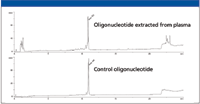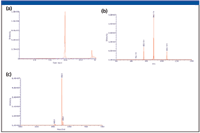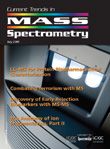ADME/Pharmacokinetic Studies from Serum and Plasma: Improvements in Sample Preparation and LC–MS Analysis of Therapeutic Oligonucleotides
Special Issues
The authors discuss improvements in sample preparation for ADME/pharmacokinetic studies of therapeutic oligonucleotides.
The paramount problem in performing absorption, distribution, metabolism, and excretion (ADME)/pharmacokinetic studies of therapeutic oligonucleotides revolves around inefficient and labor-intensive sample preparation. These traditional methods require multiple steps — liquid–liquid extraction (LLE) and solid-phase extraction (SPE) — to extract therapeutic oligonucleotides from serum and plasma for liquid chromatography–mass spectrometry (LC–MS) analysis and thus are not practical for clinical studies with large numbers of samples. Furthermore, these methods tend to yield low recoveries and poor reproducibility. This article presents a revolutionary new method for performing sample cleanup of therapeutic oligonucleotides from serum and plasma. The method extracts many types of therapeutic oligonucleotides from biological matrices in a rapid four-step SPE protocol that eliminates the need for LLE and can be automated for large sample sets. In the testing presented, different oligonucleotide samples were isolated using this methodology and analyzed at low nanogram concentrations in human and mouse plasma. The identity of the oligonucleotide and the major modifications were verified using deconvolution software. In all examples, recovery was observed to be greater than 80% with excellent sample-to-sample reproducibility regardless of the type of oligonucleotide tested (DNA, RNA, and phosphorothioate). In all cases, little or no interfering contaminants were observed. This protocol delivers a new paradigm in sample preparation for ADME/pharmacokinetic studies of therapeutic oligonucleotides.
The interest in oligonucleotide-based therapeutic drug candidates has increased dramatically in the last few years as research groups look at capitalizing on advances in aptamer, siRNA, and miRNA chemistries. Parallel advances in drug delivery technologies have allowed these potent intercellular modifiers to be delivered systemically and transported efficiently into target tissues. As candidate therapeutics move down the drug development path past compound synthesis and in vitro testing, there is a need to understand how such compounds behave in vivo. This requires understanding the pharmacokinetics of the oligonucleotide and its generated metabolites. This is a difficult proposition because it requires isolating the small amounts of oligonucleotide from plasma that contains very high amounts of proteins, salts, lipids, genomic DNA, mRNA, and cell debris. These matrix contaminants can interfere with the liquid chromatography–mass spectrometry (LC–MS) analysis that is used to identify and quantitate the therapeutic oligonucleotide and its metabolites. What further complicates the entire absorption, distribution, metabolism, and excretion (ADME) process for oligonucleotide therapeutics are the chemical characteristics of oligonucleotides — their polar and polyanionic qualities make it difficult to use standard separation procedures to clean up plasma samples for LC–MS analysis methods.
Genomic and plasmid DNA purification kits work poorly for oligo therapeutics. Previously reported methods for performing sample preparation are time consuming, using a two-step procedure of liquid–liquid extraction (LLE) and solid-phase extraction (SPE) to purify samples for LC–MS analysis (1). Such methods are impractical for typical ADME studies that require processing of hundreds to thousands of samples. A new SPE protocol enables near-quantitative recovery of oligonucleotides and their metabolites in less than 15 min. The process is automated easily using standard robotic platforms that allow rapid parallel processing of hundreds of samples. Efforts were undertaken to evaluate the recovery for several different types of oligonucleotides and their metabolites. Both DNA and RNA were spiked into plasma at different levels, isolated by the SPE procedure, and analyzed by LC–MS. Data were deconvoluted to quantitate recoveries of the parent oligonucleotide as well as any metabolites observed.
Materials and Methods
Both unmodified and phosphorothioated DNA oligonucleotides of 21–40 bases in length were ordered from Integrated DNA Technologies (IDT, Coralville, Iowa). RNA-based and other phosphorothioated oligonucleotides were provided by IDT, ISIS (Carlsbad, California) and the USC oligo core laboratory (Los Angeles, California). Solvents and reagents were obtained from Sigma (St. Louis, Missouri). Human plasma was procured from Bioreclamation, Inc. (Liverpool, New York). Oligo extraction was performed using 100 mg/3 mL Clarity OTX cartridges (Phenomenex, Torrance, California) using a standard SPE vacuum manifold (Phenomenex). LC–MS analysis of purified samples was performed on a Novatia HTCS LC system connected to a Thermo LCQ ion trap mass spectrometer (Monmouth Junction, New Jersey). Promass spectral deconvolution software linked with Thermo Xcalibur software was provided by Novatia. High performance liquid chromatography (HPLC)-UV analyses were performed on an Agilent 1200 using Chemstation software (Santa Clara, California) to monitor at 260 nm and a Clarity Oligo-RP HPLC column (100 mm × 2.0 mm, Phenomenex). A gradient method using mobile phase A (8 mm TEAA, 200 mm HFIP in water) and mobile phase B (methanol) in a gradient from 5% to 30% B in 20 min was used.
Results and Discussion
Efforts were undertaken to demonstrate the utility of using the SPE protocol for isolating short-chain oligonucleotides from serum and plasma samples with results that were comparable to what one would expect from performing ADME/pharmacokinetics studies. The key to getting any quantitative LC–MS data from a plasma sample is to remove all potential contaminants that might interfere with electrospray efficiency during the LC–MS run of the oligonucleotide. Interfering compounds from serum and plasma include salts, proteins, and lipids; the SPE cartridges use a proprietary, mixed-mode SPE sorbent to isolate short-length (less than 100mer) oligonucleotides from other components. A representation of the SPE procedure is shown in Figure 1; the procedure uses buffers that maintain near-neutral pH throughout the process to avoid unwanted modifications of the oligonucleotide (depurination for DNA below pH 5 and 2'-3' isomerization for RNA above pH 8).

Figure 1: Overview of the Clarity OTX protocol. The process can be performed in under 15 min.
Figure 2 shows an example of sample cleanup using the SPE cartridges; a 27mer DNA oligonucleotide was spiked into plasma at the 12-μg/mL level and purified for HPLC analysis using the sample cleanup cartridge. The upper HPLC chromatogram of Figure 2 is the plasma-extracted oligonucleotide and the lower chromatogram is the same oligonucleotide directly injected onto the HPLC system. Note the lack of any UV-interfering contaminants in the plasma-extracted sample. This figure demonstrates the utility of this SPE protocol to rapidly extract oligonucleotides from difficult sample matrices. Recoveries based upon HPLC peak areas indicate a 97% recovery from the plasma sample.

Figure 2: Recovery and extraction effectiveness studies of the Clarity OTX cartridge using a 27mer phosphorothioate oligonucleotide. An aliquot of 12 μg was spiked into a plasma sample, extracted, and compared to a control. Recovery of 97% is observed with little or no plasma contaminants.
While HPLC–UV data are important for high-level quantitative studies, higher sensitivity and identity data for ADME studies usually are obtained from LC–MS analysis. Figure 3 shows a typical example of an LC–MS analysis. A 19mer phosphorothioate oligonucleotide was extracted from plasma using Clarity OTX and analyzed on the Oligo HTCS LC–MS system. Figure 3a is the TIC chromatogram of the plasma-extracted oligonucleotide and demonstrates high recovery and complete removal of any MS-interfering plasma matrix contaminants. The isolated MS spectra of the main 19mer oligo peak at 14.3 min retention time is shown in Figure 3b. Major ions corresponding to the –6, –7, and –8 ions of the parent oligonucleotide are readily seen. Because oligonucleotides typically are observed as a mixture of negatively charged ions, deconvolution software is needed to positively identify all components in a sample. In Figure 3c, the deconvoluted MS spectrum is shown. Note the minor components that correspond to low-level sodium adducts as well as a small amount of depurination; these results show the necessity of using deconvolution software for identifying impurities and metabolites.

Figure 3: LCâMS chromatograms of 19mer P-S oligonucleotide extracted from plasma using Clarity OTX: (a) The MS TIC of the extracted oligo. (b) The MS spectra at main oligo peak at 14.3 min. Note the majority of ions at charge states of â6 thru â8. (c) The deconvoluted mass spectra generated by Novatia Promass software to give the expected parent mass at 6616 Da. Note the low level mass at 6482 Da that corresponds to depurination of the oligonucleotide. This example demonstrates the utility of using deconvolution software for detecting minor contaminants.
Additional experiments were performed at lower levels to get a rough estimate of the limits of detection using the SPE cartridge. In Figure 4, examples of a 19mer P-S oligonucleotide spiked into plasma and purified by SPE at the 500-ng and 50-ng levels are shown. With the 500-ng sample, a significant peak corresponding to the 19mer oligo can still be observed easily, but the TIC for the 50-ng extract cannot be seen (data not shown). However, when analyzed in selected ion mode (SIM) focusing on the "–7" ion at 944 m/z, one can quantitate the 19mer oligonucleotide easily. These results suggest that the limitations of the mass spectrometer and the acquisition method being used play a much larger role in levels of detection and that the SPE protocol appears to provide near-quantitative extraction even at low picomolar–high femtomolar oligonucleotide concentrations in plasma.

Figure 4: Aliquots of 500 ng and 50 ng spikes in plasma were extracted using Clarity OTX to determine sensitivity limits. A TIC of the 500-ng load is shown on the left. The 14.3-min peak corresponding to the 19mer P-S can still be quantitated. While a peak is not observed for the TIC of the 50 ng load, using a SIM at m/z of 944 (the â7 charge state) as is shown on the right, one still can readily quantitate the oligonucleotide at even lower levels.
Conclusions
In the drug development pipeline for oligonucleotide therapeutics, the most recent challenge has been developing robust, high-throughput methods for preparing and analyzing ADME/pharmacokinetic samples. The generated data indicate that protocols using the SPE cleanup cartridge provide a simple, sensitive, and reproducible method for removing sample matrix interference for LC–MS analysis of oligonucleotides and their metabolites. In addition, the SPE product works for the various chemistries being used for therapeutic oligonucleotides including aptamers, siRNA, miRNA, and phosphorothioates. Although not all examples are shown here, the SPE protocol works for oligonucleotide therapeutics regardless of the delivery system used, and can even be adapted to isolate oligonucleotides from primary tissues. Finally, this method can be adapted easily to high-throughput modes using standard automation instrumentation and protocols. This approach is a novel solution for one of the main problems in therapeutic oligonucleotide development.
G. Scott, B. Rivera, and M. McGinley are with Phenomenex, Inc., Torrance, California (www.phenomenex.com). M. Hail is with Novatia LLC, Monmouth Junction, New Jersey (www.enovatia.com).
References
(1) G. Zhang, J. Lin, K. Srinivasan, O. Kavetskaia, and J.N. Duncan, Anal. Chem. 79(9), 3416–3424 (2007).

High-Speed Laser MS for Precise, Prep-Free Environmental Particle Tracking
April 21st 2025Scientists at Oak Ridge National Laboratory have demonstrated that a fast, laser-based mass spectrometry method—LA-ICP-TOF-MS—can accurately detect and identify airborne environmental particles, including toxic metal particles like ruthenium, without the need for complex sample preparation. The work offers a breakthrough in rapid, high-resolution analysis of environmental pollutants.
The Fundamental Role of Advanced Hyphenated Techniques in Lithium-Ion Battery Research
December 4th 2024Spectroscopy spoke with Uwe Karst, a full professor at the University of Münster in the Institute of Inorganic and Analytical Chemistry, to discuss his research on hyphenated analytical techniques in battery research.
Mass Spectrometry for Forensic Analysis: An Interview with Glen Jackson
November 27th 2024As part of “The Future of Forensic Analysis” content series, Spectroscopy sat down with Glen P. Jackson of West Virginia University to talk about the historical development of mass spectrometry in forensic analysis.
Detecting Cancer Biomarkers in Canines: An Interview with Landulfo Silveira Jr.
November 5th 2024Spectroscopy sat down with Landulfo Silveira Jr. of Universidade Anhembi Morumbi-UAM and Center for Innovation, Technology and Education-CITÉ (São Paulo, Brazil) to talk about his team’s latest research using Raman spectroscopy to detect biomarkers of cancer in canine sera.